Salesforce Account Object Best Practices
- May 1, 2023
- Salesforce and Pardot, Salesforce Ben | The Drip
Out of the box, Salesforce has quite a few objects and fields readily available for you and your team to use. These help you make the most out of your CRM right from the get-go. Opportunities, Leads, Cases, and of course Accounts are examples of such objects, as most businesses can easily use these to translate their new or existing business processes in Salesforce.
This post will cover a few tips and tricks to consider when using the standard Salesforce Account object.
What Is the Salesforce Account Object?
In comparison with other objects, the definition of an Account is very straightforward – it represents companies (or individuals) whom your company will do business with. More often than not, the Account can easily serve as the ultimate umbrella for everything else related to either a sales or support process.
For example, we know for sure that any company will have employees, and those will be represented as Contacts related to an Account in Salesforce. Similarly, at some point in time a sale will be in the works, and that will be represented by an Opportunity related to the Account.

1. Business vs. Person Accounts
Regardless if you are selling to other companies only (B2B) or to individual customers (B2C), the processes can be accommodated out-of-the-box in Salesforce through the use of Person Accounts alongside the Business ones.
- Business Accounts: Represent other companies that you do business with, which have multiple employees associated with them as Contacts.
- Person Accounts: Represent individual persons you are selling your products or services to. While these do not have associated Contacts as the functionality combines some Account and Contact fields into the Person Account, they can be associated with Opportunities and other objects.
Although a while ago Salesforce Support would be needed to enable Person Accounts for you, it can now be done directly in Setup following a checklist. One thing to note is that record types should be enabled on Accounts, as at least one of them should be set up. Additionally, you have to acknowledge that once enabled, Person Accounts cannot be disabled.

Prior to enabling Person Accounts in production, you should test the particularities out in a Sandbox, as well as revise the documentation and how these would behave in relationship with the other features.
2. Define Your Account Creation Process
This one may prove to be one of the most important aspects in keeping the Account records and data quality on track, considering that Accounts may be created from different sources as well as different teams.
- Lead Conversion: If Leads are in use in the org, accounts can be created through the lead conversion process if needed. In this case, you can use the LeadConvertSettings, which can be found by clicking on the Map Fields button to decide which data is transferred over from custom fields on the Lead to custom fields on the Account.
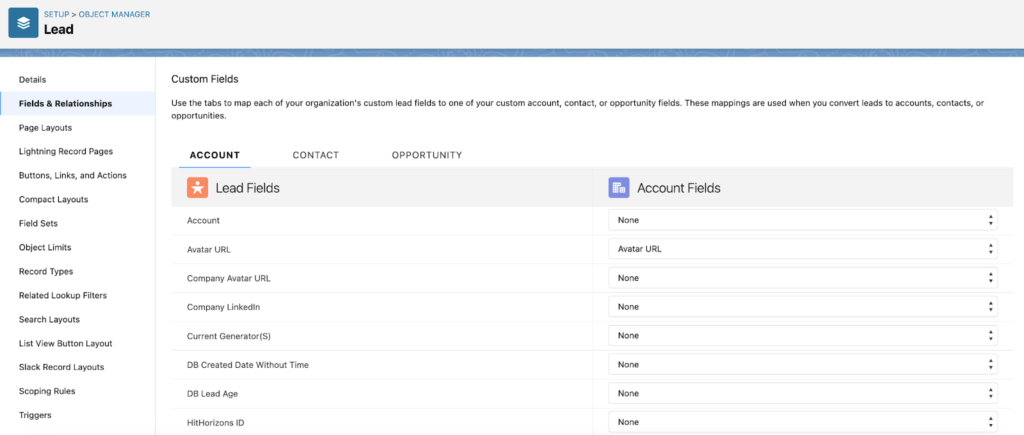
- Data Import: Decide when and who can mass import new Accounts, and of course the minimum data requirements to ensure a desired completion rate. This can be easily enforced through validation rules or by making certain fields required.
- New Account button: Either Salesforce Admins or Users can create accounts manually – it is the company’s decision whether they should be allowed to do so or not, and who can insert the new data.
While you may end up not heavily restricting the creation permissions, a thorough conversation as well as user enablement should happen. Additionally, I recommend exploring duplicate rules and enabling them to ensure that there is no overlap between teams which may end up working with the same company.
3. Know What Information Your Users Need
When first starting to use Accounts in Salesforce, you will notice a plethora of fields there ready to use for you to get started. Additionally, you can create the custom fields that are needed in order to satisfy business requirements specific to your organization pertaining to the Account data.
As you may already know, this can turn into a very lengthy conversation involving multiple stakeholders, as users may just request additional fields when they are not aware of already existing functionality. Some teams and individuals should only have access to certain fields and records, while others should be able to both view and edit the information.
This means that while you as a Salesforce Admin should be aware of the object limits for each of the objects, these discussions are then bound to drift to permissions, sharing settings, personas, and potentially record types and enablement.
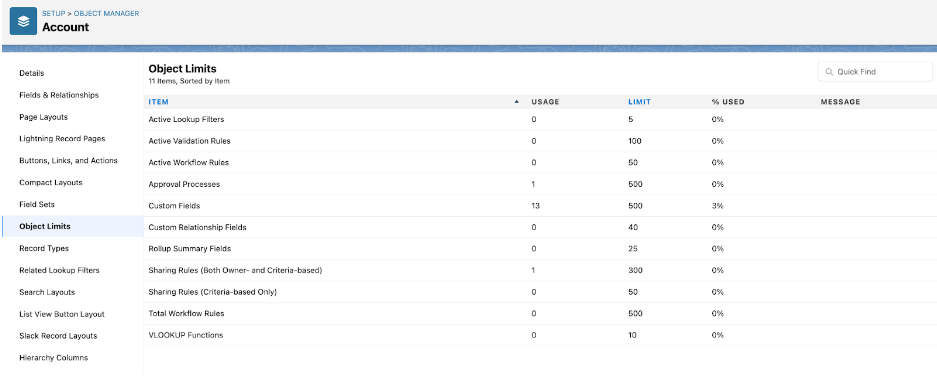
4. Account Team
The Account Team represents the individuals in your organizations who closely collaborate towards the success of a certain Account, be it the Sales Managers, Customer Success Team or even technical teams. This out-of-the-box functionality can be used to rapidly relate everyone who is involved (in one way or another) to the Account record.
Of course, there is more to the Account Team than meets the eye: not only can the Default Team defined at each user’s level be added, but for every Account Team Member, the read or write record access can be defined for the Account as well as related Opportunities, Contacts, and Cases.
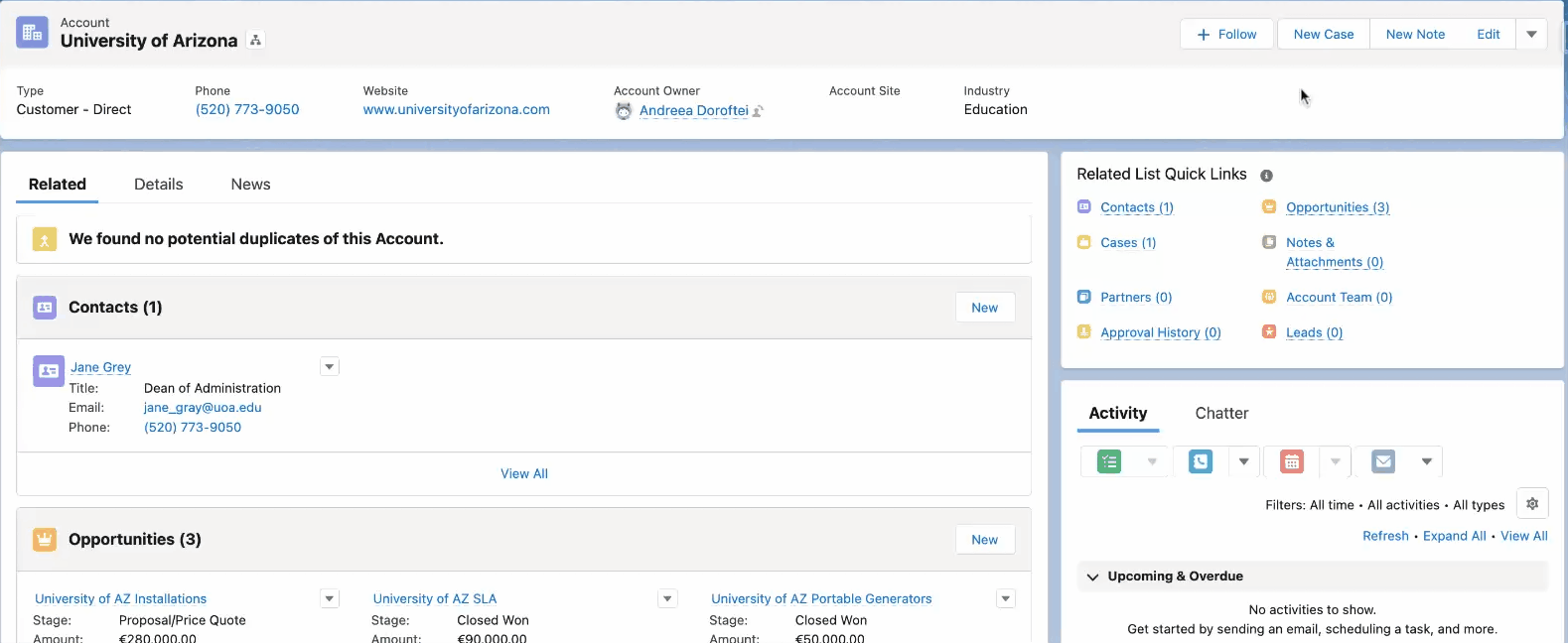
5. Account Hierarchy
The Account Hierarchy in Salesforce is yet another handy feature, especially when working with big corporations that have multiple international entities. Using the standard Parent Account field, you can relate one Account to another to build and then easily view all related companies in your Salesforce instance. Of course, this information can be later used in reporting as well as additional processes or validations.

Note: Person Accounts cannot be included in Account Hierarchies.
6. Contacts to Multiple Accounts
Particularly in a B2B context with large purchases and implementations, chances are that employee relationships to certain companies are not necessarily linear. One example being the channel sales situation where a partner is supporting another organization with their purchase and/or implementation.
The Contacts to Multiple Accounts functionality is something you can enable yourself within the Account settings in Setup, and this will surface the Related Contacts related list that can be added to the Account layout. Contacts from different Accounts can be related in different roles, without having to reparent them or duplicate the data.
Also, additional fields can be added on the Account Contact Relationship layout to note if the relationship is still active (IsActive standard field), or if you’d like to store other custom information custom fields can be created.
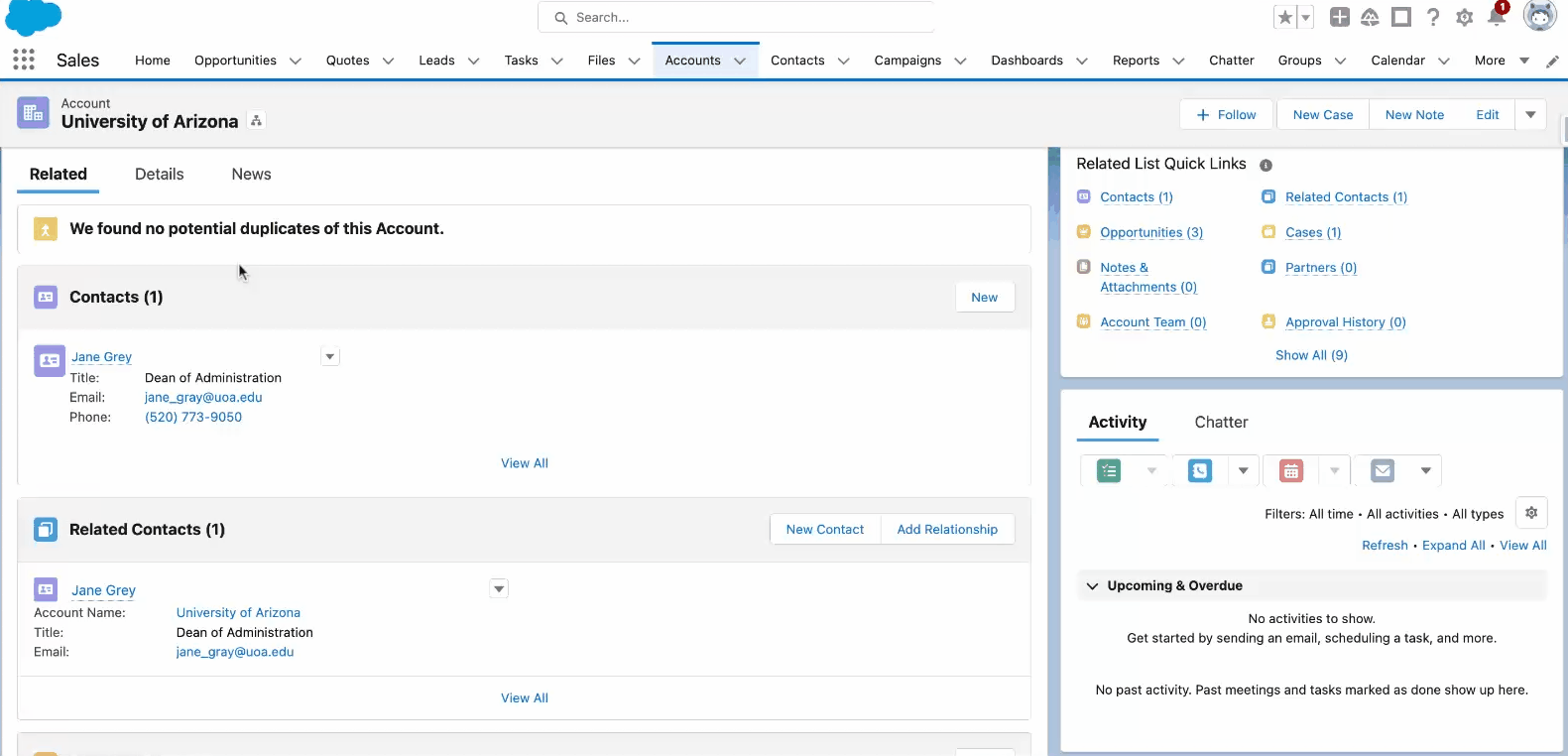
7. Lead to Account Matching
If your company is using Salesforce Leads, then there is likely to be situations where new Leads will come through that are employees of already existing Accounts. In this situation, a Lead to Account matching process not only makes sense, but will also ensure that the Account Owner has full visibility into their Account’s end-to-end activity.
Not only can you choose to build an automation using Salesforce Flow and a lookup field for example, but you can further enhance the automation to send notifications or even change the Lead ownership.
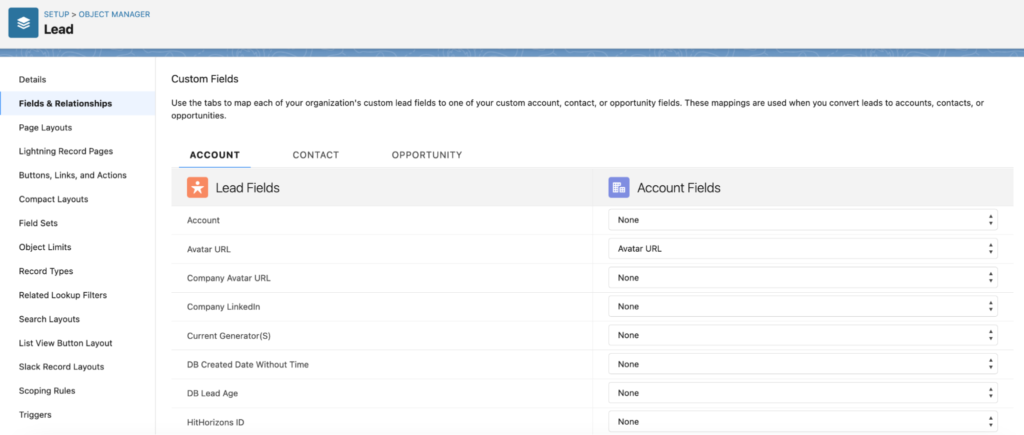
8. Formula Fields and Process Automation
Similar to other standard or custom objects, Accounts can benefit from the custom features your Salesforce team build in-house to meet the specific business requirements pertaining to your company’s processes. Be that calculated formula fields, or simple/more complex automations, there are countless ways you can reduce the time your users spend clicking through Salesforce.
For example, a simple record-triggered flow can be fired whenever the industry is changed to create a task for the Account Owner to update the Account plan.

Note: The tutorials we are showcasing are built in Developer Edition orgs with limited data and only a few custom automations. Ensure that you evaluate your existing processes properly before building new ones, including both declarative automations and custom Apex. For Flow specifically, consider the recommended best practices when it comes to the number of record-triggered flows per object.
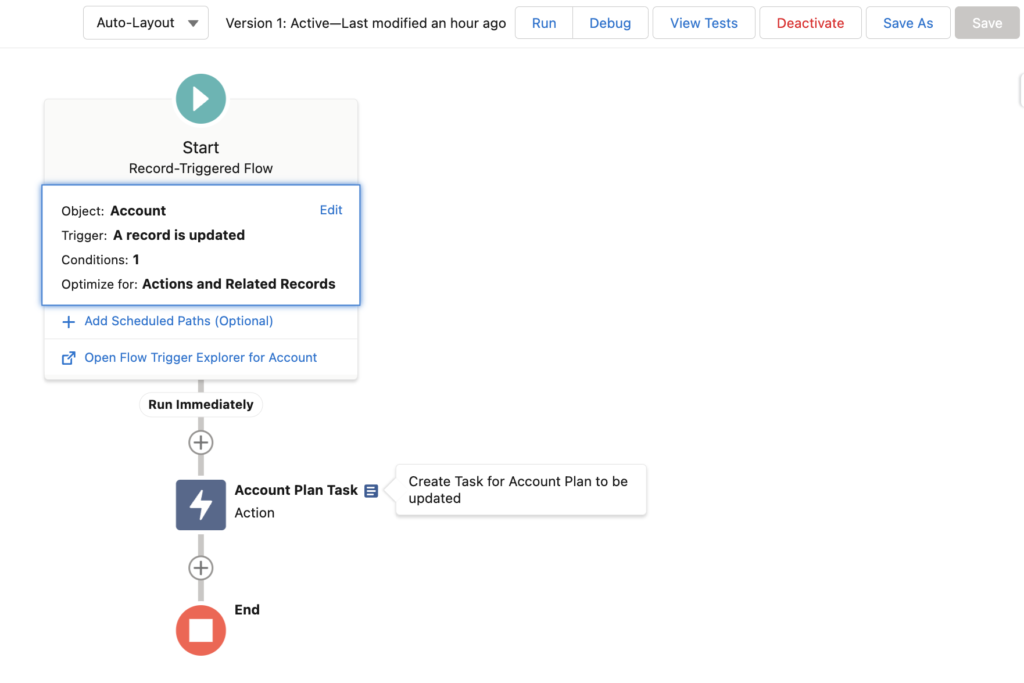
9. User Experience
Following all the amazing things you can do related to the Salesforce Account object in your instance, the user experience along with enablement are the key to success. Even if the solutions you deliver are helpful and scalable, users still have to get accustomed to using them, and also see the value they bring.
One thing that I always go back to for quick wins is definitely the Record Page. With a wide variety of out-of-the-box components to use, it is quite hard to decide on only a few, but in the end it all comes down to the particularities of your users and processes. To begin with, it’s worth exploring at least the following:
- Custom Tabs: To avoid clutter on the page, it’s very convenient that multiple separate tabs can be created within the tabs component, and renamed as needed to group other components. Additionally, you can choose which of the tabs is the default one when opening the record.
- Dynamic Actions: This still relatively new feature allows you to decide which of the actions show up on the record page, and you can filter them based on criteria.
- Related List Quick Links: With the Account being an object with a lot of other related objects, offering users a way to easily use the Account Team, for example, or access the Opportunities can save quite a few clicks along the way.
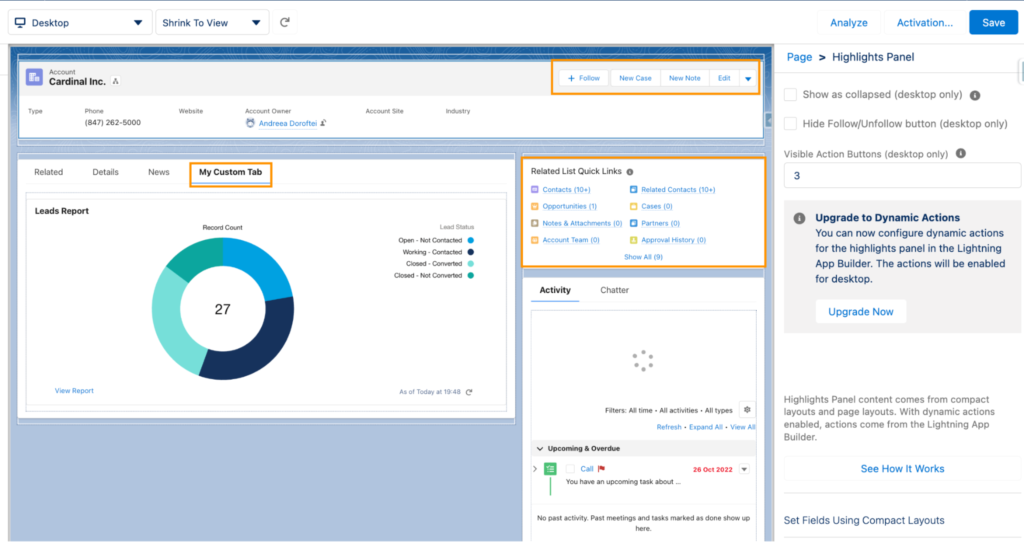
10. Accounts are Not Only for Sales
As mentioned above, the Salesforce Account object can easily be seen as one of the most important objects in your instance. On top of Sales and Sales Operations using them, other teams can definitely benefit from the information stored at Account level, and further use these records in other processes – the Marketing team is just one example.
Accounts as Campaign Members is a functionality which enables individual Account or Person Account records to be added to campaigns, and be further monitored similar to as you would other Campaign Members. This feature has to be enabled in Setup, and can come in handy especially for Account Based Marketing initiatives.

Final Thoughts
All in all, each Account-related process can be quite different from org to org, hence the important part being to know all of the different out-of-the-box possibilities you as a Salesforce Admin can use before proceeding with other options such as creating custom objects.
Make sure to keep up to date with new functionalities and enhancements by reading the release notes Salesforce provides – see our Summer ’23 release notes here.
This Pardot article written by:
Salesforce Ben | The Drip
Lucy Mazalon is the Head Editor & Operations Director at Salesforceben.com, Founder of THE DRIP and Salesforce Marketing Champion 2020.
Original Pardot Article: https://www.salesforceben.com/best-practices-salesforce-account-object/
Find more great Pardot articles at www.salesforceben.com/the-drip/
Pardot Experts Blog
We have categorized all the different Pardot articles by topics.
Pardot Topic Categories
- Account Based Marketing (ABM) (7)
- Business Units (14)
- ChatGPT / AI (3)
- Completion Actions (5)
- Connectors (10)
- Custom Redirects (4)
- Data Cloud (3)
- Demand Generation (8)
- Dynamic Content (7)
- Einstein Features (11)
- Email Delivery (17)
- Email Open Rates (3)
- Pardot A/B Testing (2)
- Email Mailability (16)
- Do Not Email (1)
- Double Opt-in (2)
- Opt Out / Unsubscribe (14)
- Email Preferences Page (6)
- Engagement Studio (16)
- Industries (1)
- Non Profit (1)
- Landing Pages (9)
- Lead Generation (1)
- Lead Management (13)
- Lead Routing (3)
- Lead Scoring (16)
- Leads (3)
- Marketing Analytics – B2BMA (9)
- Marketing Automation (1)
- Marketing Cloud (3)
- Marketing Cloud Account Engagement (4)
- Marketing Cloud Growth (2)
- New Pardot Features (6)
- Opportunities (2)
- Optimization (2)
- Pardot Admin (65)
- Duplicates (1)
- Marketing Ops (1)
- Pardot Alerts (1)
- Pardot API (2)
- Pardot Automations (3)
- Pardot Careers (12)
- Pardot Certifications (4)
- Pardot Consulting (1)
- Pardot Cookies (4)
- Pardot Custom Objects (3)
- Pardot Email Builder (8)
- Pardot Email Templates (10)
- HML (6)
- Pardot Events (17)
- Pardot External Actions (1)
- Pardot External Activities (4)
- Pardot Forms (29)
- Form Handlers (8)
- Pardot Integrations (21)
- Data Cloud (2)
- Slack (1)
- Pardot Lead Grading (5)
- Pardot Lead Source (2)
- Pardot Lightning (1)
- Pardot Migration (1)
- Pardot Nurture / Drip Campaigns (2)
- Pardot Personalization (3)
- Pardot Profiles (1)
- Pardot Releases (18)
- Pardot Sandboxes (2)
- Pardot Segmentation (5)
- Pardot Strategy (7)
- Pardot Sync (2)
- Pardot Sync Errors (1)
- Pardot Tracker Domains (5)
- Pardot Training (3)
- Pardot Vs Other MAPs (4)
- Pardot Website Tracking (2)
- Reporting (22)
- Salesforce and Pardot (31)
- Marketing Data Sharing (2)
- Pardot Users (3)
- Salesforce Automation (5)
- Salesforce Flows (2)
- Salesforce Campaigns (22)
- Salesforce CRM (3)
- Record Types (1)
- Salesforce Engage (3)
- Salesforce Queues (2)
- Security and Privacy (1)
- Tags (3)
- The Authors (540)
- Cheshire Impact (9)
- Greenkey Digital (55)
- Invado Solutions (37)
- Jenna Molby (9)
- Marcloud Consulting (6)
- Nebula Consulting (67)
- Pardot Geeks (44)
- Salesforce Ben | The Drip (242)
- SalesLabX (16)
- Slalom (4)
- Unfettered Marketing (51)
- Uncategorized (1)
- Website Tracking (2)
- Website Search (1)
More Pardot Articles
See all posts
This Pardot article written by:
Salesforce Ben | The Drip
Lucy Mazalon is the Head Editor & Operations Director at Salesforceben.com, Founder of THE DRIP and Salesforce Marketing Champion 2020.
Original Pardot Article: https://www.salesforceben.com/best-practices-salesforce-account-object/
Find more great Pardot articles at www.salesforceben.com/the-drip/






